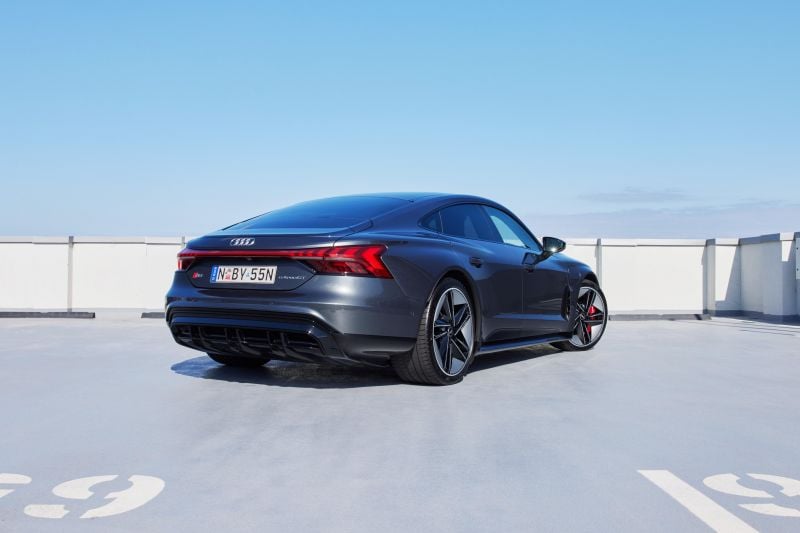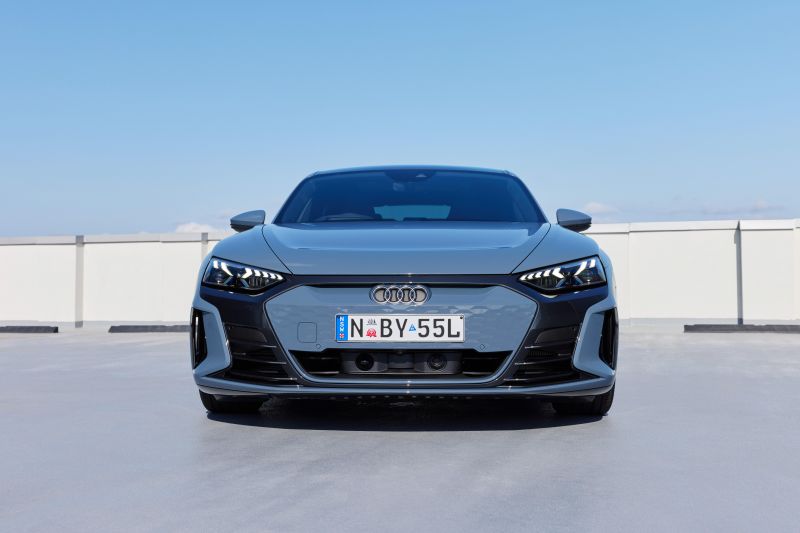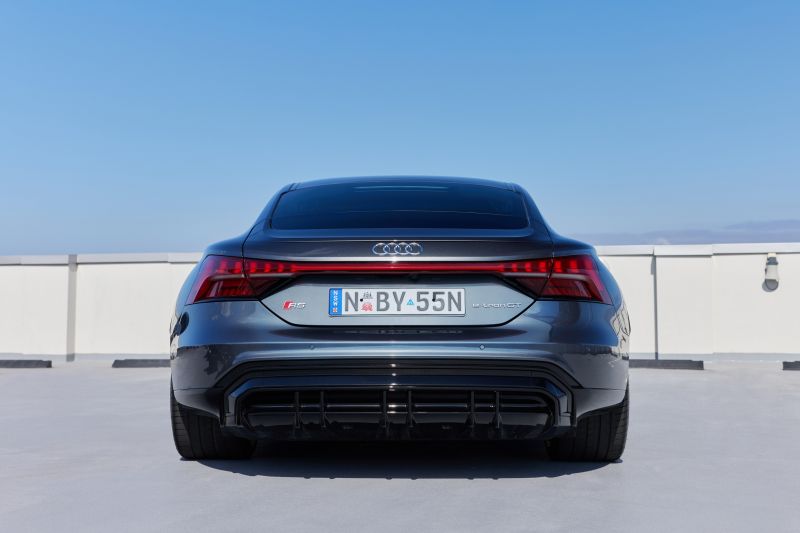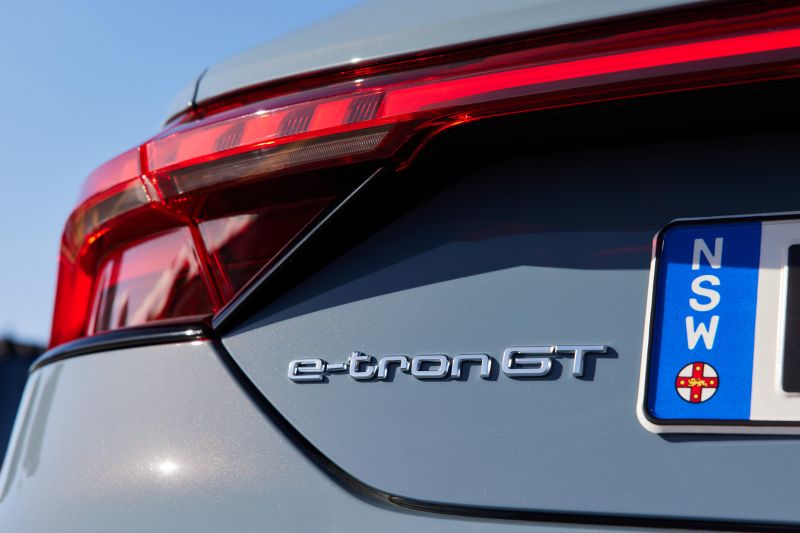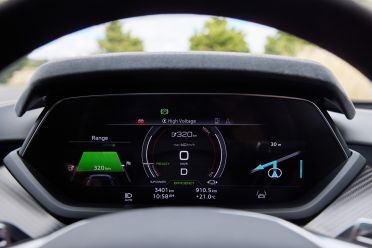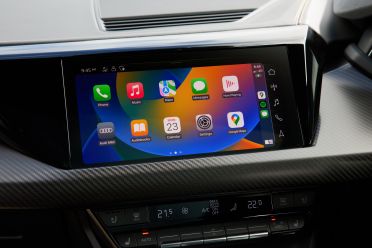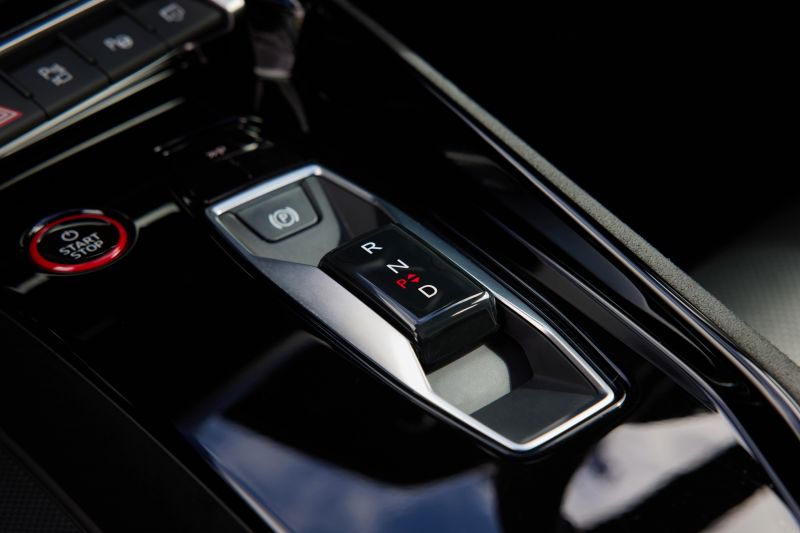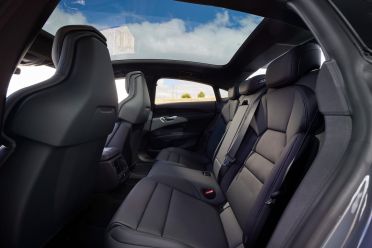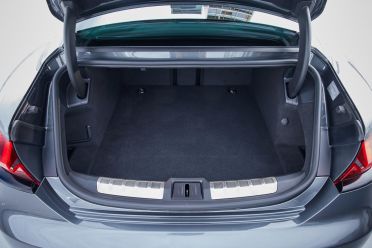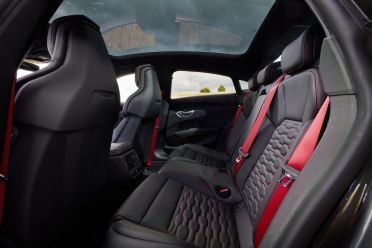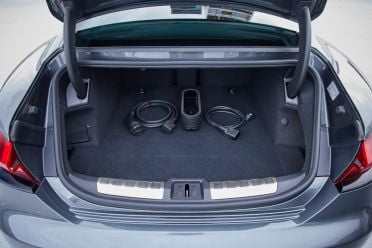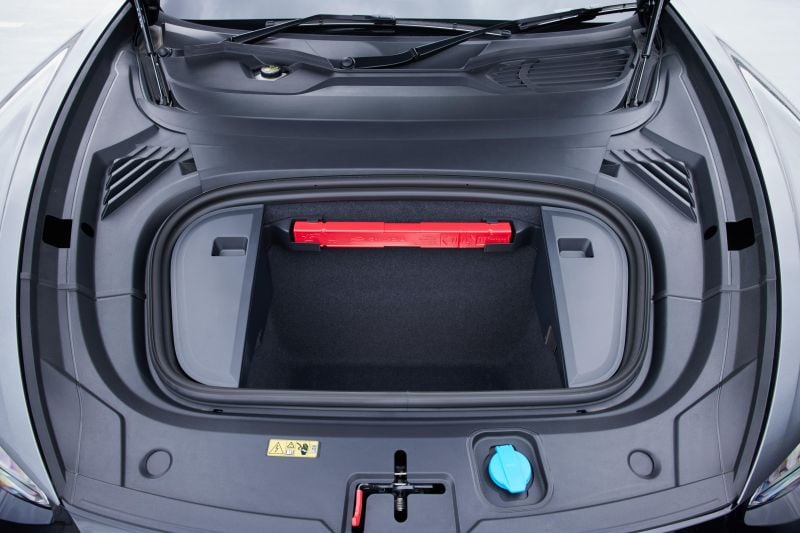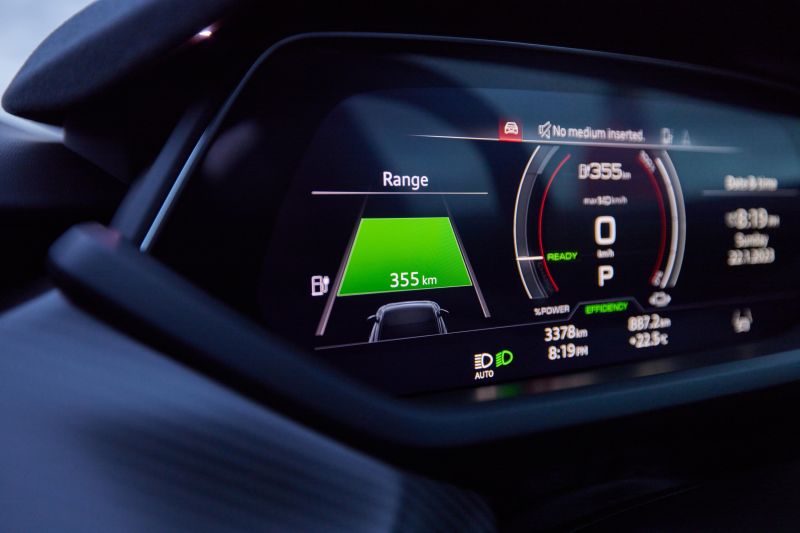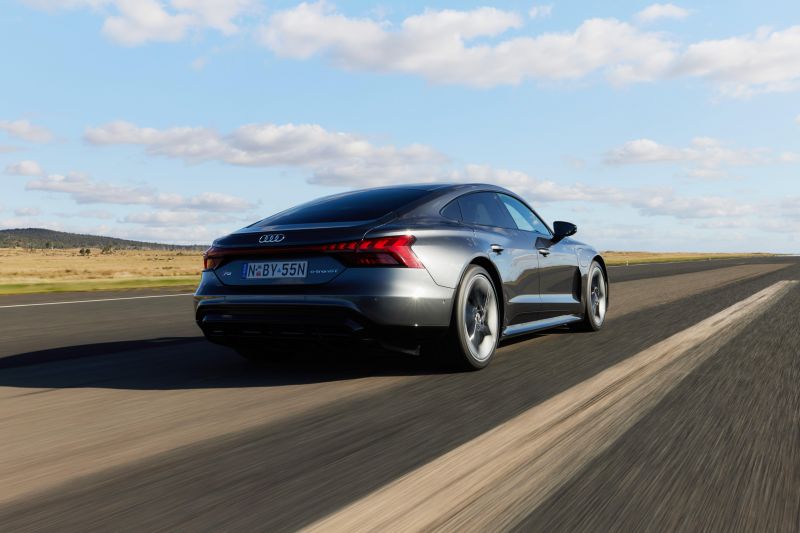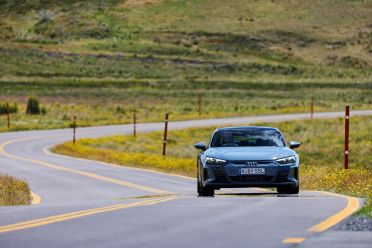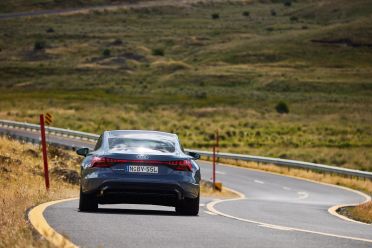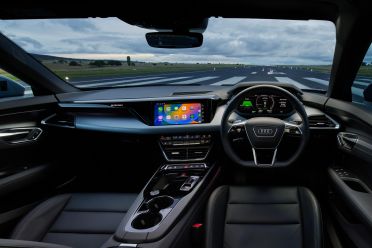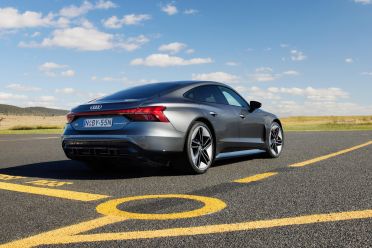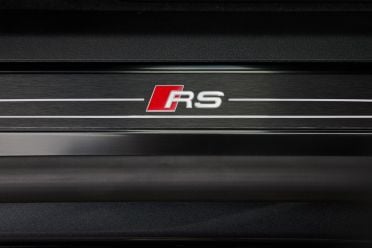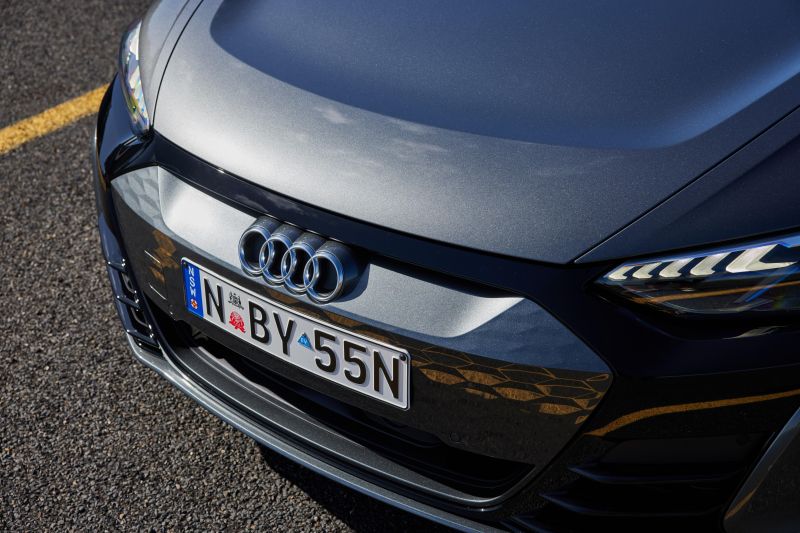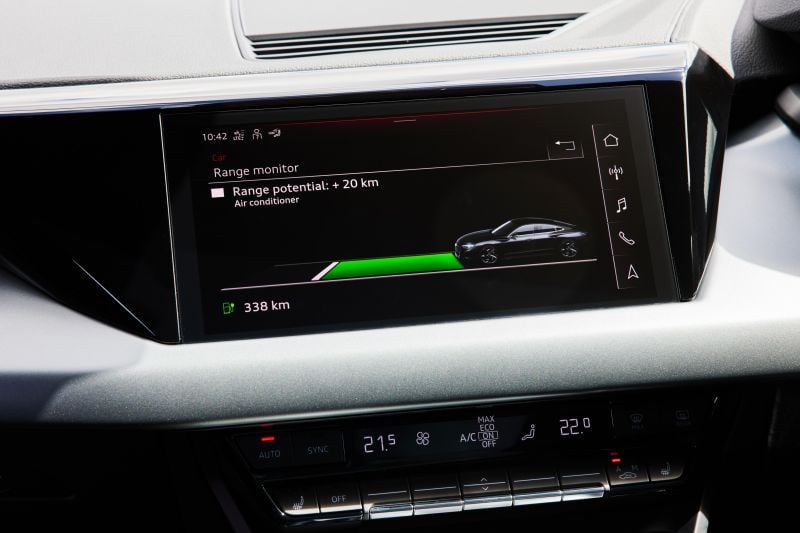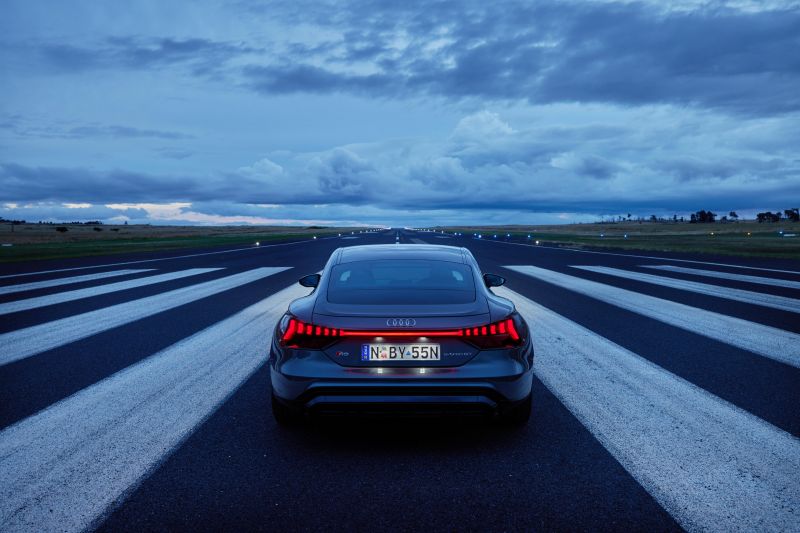Like so many cutting-edge all-electric vehicles these days from legacy brands and newcomers alike, the all-new Audi e-tron GT immediately assumes the coveted position as the most powerful series production Audi ever built.
Built on the same shared J1 electric car platform as its ballistically quick Porsche Taycan cousin, the Audi e-tron GT quattro and it’s top-shelf RS e-tron GT stablemate use two electric motors with a 93.4kWh battery, which under full boost is capable of making up to 475kW and 830Nm (390kW/630Nm for the regular e-tron GT).
Both models also share the same two-speed transmission which helps with those sunglass-removing launches when Dynamic drive mode is selected. No joke – if you’ve never launched a proper hi-po EV, you’ll need to hang on tight and hold onto those Ray Bans, and the e-tron GT in any guise is no exception.
Nevertheless, some might see the Audi’s driving range as something of a drawback to the likes of the BMW i7 (625km) or the Tesla Model S (652km) – if only you could buy one here. The e-tron GT claims a maximum range of 540km for the entry version (NEDC) and 504km for the RS, but on the plus side is able to recharge at 270kW via DC charging – sufficient for a 100km top up in just five minutes.
It’s also the first-ever battery electric Audi to wear the prized RS badge and draws on the dynamic engineering experience of the high-performance Audi Sport division. Without jumping the gun, this is a very accomplished four-door sedan more than capable of crushing your favourite fast-flowing twisties.
There will undoubtedly be those who will seek to compare Audi’s e-tron GT with its Porsche Taycan relative on sheer accelerative pace alone, but the different designs should tell you quite clearly these are vastly different performance propositions that should appeal to different buyers entirely.
The futuristically-designed Porsche is an all-out electric sports car designed to appeal to the well-heeled enthusiast ready to ditch old-world combustion-engined sports cars for a new era of performance motoring devoid of gas stations and high fuel prices. Or, they have one foot in each garage door is another likely scenario.
While non-car people may not immediately recognise the Taycan as a Porsche, there’s no mistaking the e-tron GT for anything other than an Audi, enthusiast or not. Perhaps one of the best looking Audis ever built, even.
Whatever your take, it’s a stunning design; long, wide and ultra-low slung with a suitably muscular stance, as a more subtle nod to the future of high-performance motoring than its overtly-styled Taycan relative.
The designer is head of Audi Design, Marc Lichte – of VW Golf Mk 5,6 and 7 fame among many others including the Volkswagen Arteon, but he counts the Audi e-Tron GT as, “the most beautiful car that I have ever designed.” There’s no argument here.
The immediate giveaway to its EV powertrain is the closed-off grille but with an interesting, if not future-like graphic where you would normally find Audi’s signature single-frame design on an ICE car.
Down below is a horizontal panel incorporating cameras and radar along with active slats for cooling and airflow that help the e-tron GT achieve a drag coefficient of 0.24. Interestingly, the e-tron GT sits even lower than the ultra-rapid Audi RS7.
The cutting-edge Matrix LED headlamps with laser light set help set the e-tron GT’s ground-hugging stance, as do the 21-inch, diamond-turned aero-styled alloy wheels on the RS version, though the 20s on the regular model are also suitably contemporary and fill the wheel arches nicely.
Out back, is possibly my favourite point-of-view of the RS e-tron GT we spent most time in – especially in its Tango Red paint job. The rear lights and graphics are spectacular, but more so when they present on-off light show at night.
There’s also a hidden rear spoiler that deploys at two different angles depending what speed you’re travelling. At 90km/h it’s in its aero-efficient mode, but at 170km/h it acts as a downforce generator.
Below decks is a serious looking diffuser with additional aero functionality, and if you get the carbon exterior package on either version, you also get carbon roof as well as a complete black pack including the Audi rings. At a minimum cost of $15,000, it’s more expensive than ceramic brakes, but it does look schmick.
All the panels (except for the carbon roof) are aluminium, with a combination of hot-stamped steel and beefier aluminium extrusions for a worthy crash structure.
The lightweight formula continues with cast-alloy suspension towers with e-tron GT’s triple-chamber air suspension as standard. It allows the car to be lowered by up to 22mm and as little as 10mm.
Underneath, the Audi e-tron GT gets a completely flat floor, but with hundreds of carefully shaped and positioned inputs – using similarly aerodynamic properties as the dimples on golf balls. The attention to detail is impressive.
Even at idle e-tron GT looks fast, but it’s also a genuine Gran Turismo as its GT badge clearly suggests. It’s also a very, very quick one, especially in RS trim, though not quite as warp-speed rapid as the Taycan Turbo S – but let me assure you, it does fast EV luxury extremely well.
Interestingly, the e-tron GT isn’t built alongside the Taycan or even at the same location as the Porsche despite the shared platform.
Rather, it’s built alongside Audi’s mid-engined R8 supercar at its Neckarsulm factory, so you’d have to think there might be something of a cap on the sheer volume of e-tron GTs Audi can effectively build in comparison to Taycan’s dedicated production line at Zuffenhausen.
That alone might have the effect of billing the e-tron GT as something more exclusive than the Taycan despite costing considerably less in general terms, although, Porsche also offers a cheaper entry point with a rear-wheel drive version, whereas the Audi boasts quattro all-wheel drive as standard on both e-tron models.

How much does the Audi e-tron GT cost?
The Audi e-tron range starts with the e-tron GT quattro priced from $180,200 plus on-road costs, while the faster RS e-tron GT costs $248,200 before on-roads.
2023 Audi e-tron GT pricing:
- Audi e-tron GT quattro: $180,200
- Audi RS e-tron GT: $248,200
Prices exclude on-road costs
By way of comparison the Porsche Taycan is noticeably more expensive when comparing like-for-like performance specs. At least, unless you opt for the entry-level, rear-drive version mentioned above, which undercuts the regular e-tron GT by some margin with a starting price of $158,100.
The equivalent Taycan specification to the ‘standard’ e-tron GT is the Taycan 4S, which starts at $197,200 before on-roads; while the RS e-tron GT’s Porsche equivalent is the Taycan Turbo – priced from $280,300 in Australia.
What is the Audi e-tron GT like on the inside?
Most of our time was spent behind the wheel of the flagship RS e-tron GT, but both versions of Audi’s all-electric four-door coupe are incredibly well equipped with a host of high-end equipment and features as standard – it’s a thoroughly sumptuous cabin in every respect.
But here’s the thing. It looks and feels like any other top-shelf Audi at similarly high price points, so Audi owners transitioning from ICE cars to EVs will be instantly at home in the driver’s seat in the e-tron GT.
That’s a different proposition to the Porsche Taycan, which carries its futuristic design on the outside into the cabin itself for a seamless next-generation experience, though not as outright luxurious as the Audi e-tron GT.
Either way, there’s something to be said for familiarity of features and ergonomics when jumping from one Audi to another, or indeed, from any other ICE branded car to a luxury EV such as the e-tron GT.
The combination of brushed alloy brightwork, swathes of Alcantara with contrast red stitching and some of the best Nappa leather sports seats in the game is an inviting proposition on any given day.
There’s Audi’s trademark dual-screen set-up incorporating a large configurable digital instrument cluster, head-up unit and touchscreen infotainment display.
The 16-speaker B&O audio system (standard even on the regular model) is truly superb for its breadth of highs and lows and all-round clarity.
It’s all beautifully tasteful as we’ve come to expect from high-end Audi’s and I like the Audi’s take on the electronic shifter, but you might struggle to find enough space up front in the console for keys, wallets and sunnies.
There’s a not-so-obvious wireless charging cradle inside the centre-console bin – but you’ll need some practice sliding it in there a few times before it becomes an eye’s-closed operation.
I’m not generally a fan of Alcantara steering wheels either (too hard and less grip in the hands than a good leather wrapped version), but the flat-bottom version in our RS e-tron tester is excellent in both respects.
The driving position itself it deep set and lower than you might expect even of a high-speed Audi EV, but given its blistering performance weaponry, you’ll love it once your drop in and prepare for a full-scale assault on the twisties. The whole fit and feel is very driver-centric and somewhat Porsche-like if I’m honest.
Forward vision over that sprawling bonnet is perfect for positioning the car on road with pinpoint accuracy, but it’s another matter entirely when it comes to the view out of letterbox window out back. Parking sensors and cameras are mandatory in tight spaces.
While legroom and elbow space in the second row seating is ample, taller frames above 190cm will likely struggle to find sufficient headspace.
Boot space isn’t overly generous either if judged purely on available litres (350L for the RS e-tron & 405L for the regular version), but we managed to squeeze in multiple soft bags during our drive.
What’s under the bonnet of the Audi e-tron GT?
Both the Audi RS e-tron GT and regular e-tron GT quattro use a 93.4kWh battery (net capacity 83.7kWh) with dual electric motors – one front, one rear – with all-wheel drive through a two-speed transmission (like the Taycan).
Under normal conditions the base e-tron GT produces 350kW of power (390kW in boost mode) and 630Nm of torque, which is good for a 0-100km/h dash in 4.1 seconds.
Meanwhile the more powerful RS e-tron GT makes 440kW (475kW in boost mode) and 830Nm, with 0-100km coming up in just 3.3 seconds.
Audi claims a range of 540km (NEDC) for standard e-tron GT and 504km for the RS e-tron GT, although both models claim a WLTP driving range of 488km.
Local specs for the e-tron GT list energy consumption rates of 19.2kWh per 100km for the standard variant and 20.2kWh per 100km for the RS e-tron GT.
While e-tron GT buyers will get a 7.2kW single phase wall charger box as standard, Audi offers a 22kW three-phase charger as an option which upgrades the vehicle’s on-board charger as well as the external charger to 22kW capacity.
The e-tron GT’s 800V electrical architecture also allows for up to 270kW DC fast charging, which can deliver 100km of range in five minutes, or top the battery up from five per cent to 80 per cent in 22.5 minutes.
The good news is Audi is offering all e-tron GT buyers a free six-year subscription to the Chargefox charging network with unlimited charging at its ultra-rapid, fast and standard charging facilities.
How does the Audi e-tron GT drive?
As luck would have it, we were assigned the RS e-tron GT first up and ended up staying in it for the most of the drive program in and around the NSW Snowy Mountains region with only a short time behind the wheel of the regular e-tron GT.
You tend to kick off in the least aggressive Comfort drive mode, mostly to get a baseline fix on response rates and ride compliance, which is understandably good given e-tron GT’s three-chamber air suspension.
However, with the temptation of clear roads ahead and a dry surface (after the storm on the way down) we dialled up Dynamic mode for the quickest throttle response and rock solid chassis control as we came across some superb rolling-hills terrain in these parts.
Charging along at a solid pace you quickly relish just how wonderfully balanced this car is, despite tipping the scales at 2345kg and slightly less for the e-tron GT.
Nevertheless, it feels massively planted and surefooted under rapid changes of direction with superb steering feel. The weighting on centre is comfortably firm and the rack itself seems more natural than most other EVs I’ve driven, even the Taycan.
The driving dynamics are further enhanced by the combination of all-wheel steering (RS e-tron GT) and e-quattro sport differential with torque vectoring.
In fact, it feels more stable through the bends as the very best Audi’s I’ve driven, thanks to that ICE-like feel behind the wheel.
It’s completely linear in terms of acceleration, steering and braking and something I wasn’t really expecting of the RS e-tron GT. Mind, the regular e-tron GT is noticeably less sharp, especially in the steering department.
That’s down the lack of all-wheel steering in standard trim, though, it might be worth getting as part of the optional Dynamic Plus Package, which also adds a sport differential and torque vectoring as well as more powerful carbide brakes.
Mind, Audi hasn’t really bought into the one-pedal driving routine like Porsche has adopted for the Taycan. The left-hand paddle-shifter allows for just two-stages of regen in the Audi, but from my perspective its barely noticeable with only a very slight effect on slowing the car down when you come off the brake pedal proper.
It’s nowhere near enough for my taste and can’t help think more is better with this genre of EV, but some people might find that comforting in the transition to an all-electric high-end Audi. It’s certainly a different approach to some rival high-performance EVs and one which clearly separates the e-tron GT and Taycan driving experience, at least.
You can’t fault the ride comfort, though. Even in the most aggressive Dynamic setting there’s sufficient compliance in the air suspension to cushion the smaller potholes without unsettling the car in any way.
The ease and speed with which you can cover ground is uncanny for what is a luxury GT car, and any disappointment around the lack of regen braking is largely eclipsed by utterly natural calibration of all the major controls.
What do you get?
e-tron GT highlights:
- 6-year subscription to Chargefox network
- 11kW AC home charger with wall mount box
- 10.1-inch touchscreen infotainment system
- 12.3-inch virtual cockpit digital instruments
- Wireless Apple CarPlay, Android Auto
- Qi wireless phone charging
- 16-speaker Bang & Olufsen 3D sound system
- DAB+ digital radio
- Head-up display
- Satellite navigation
- Adaptive air suspension
- Panoramic glass roof
- Matrix LED headlights with Audi laser light
- Tyre pressure monitoring
- Automatic headlights
- Rain-sensing wipers
- Keyless entry and start
- Hands-free power boot lid
- Tri-zone climate control
- Heated, power-folding exterior mirrors
- Heated washer jets
- Leather upholstery
- Power-adjustable front seats
- Heated front seats
- Paddle shifters
- Leatherette-wrapped console surround, door inserts, instrument cowl
- Graphite grey interior inlays
- 20-inch alloy wheels
RS e-tron GT adds:
- All-wheel steering
- Controlled rear differential lock
- Body-colour grille
- Nappa leather upholstery
- Colour ambient lighting
- Heated steering wheel
- Ventilated front seats
- 4-way lumbar support
- Extended Nappa leather/Dinamica interior upholstery
- Carbon twill inlays
- RS e-tron sport sound
- 21-inch alloy wheels
Options
In addition, the e-tron is available with six optional packages covering dynamics and trim upgrades:
Carbon and black exterior styling package: e-tron GT $17,500; RS e-tron GT $15,000
- Carbon roof (removes glass roof)
- Carbon exterior mirror caps
- Front side air intakes, side sills, rear diffuser in carbon
- Black exterior badges
- Black exterior styling package (e-tron GT)
Dynamic plus package: $10,500 (e-tron GT)
- e-quattro sport differential with torque vectoring
- All-wheel steering
- Performance braking system
- Red brake calipers
Premium plus package: $6400 (e-tron GT)
- 20-inch alloy wheels with black elements
- Colour ambient lighting
- Privacy glass
- Air quality package
- Illuminated aluminium door sills
Dinamica interior package: $8000 (e-tron GT)
- 14-way ‘Sport plus’ front seats with 4-way lumbar support
- Power-adjustable thigh support
- Dinamica upholstery with leather bolsters and head restraints
- Dinamica headliner
- Dinamica centre console surround, door inserts, instrument cowl
Sensory package: $8400 (RS e-tron GT)
- Massaging front seats
- Heated outboard rear seats
- Air quality package
- Illuminated door sills with carbon inlay
- Dinamica headliner
Red/Grey RS design package: $4550 (RS e-tron GT)
- Alcantara-wrapped steering wheel
- Nappa leather-wrapped dashboard, centre console and door armrests
- Dinamica centre console surround, door inserts and instrument cowl
Ceramic brakes with either red, blue or grey calipers are a $13,500 option on the RS e-tron GT. A body-colour grille is an $800 option on the e-tron GT, while walnut grey-brown inlays are a $1850 option.
Colours
- Ibis White
- Floret Silver metallic
- Suzuka Grey metallic
- Daytona Grey pearl
- Kemora Grey metallic
- Mythos Black metallic
- Tango Red metallic
- Ascari Blue metallic (RS e-tron GT)
- Tactical Green metallic (RS RS e-tron GT)
All finishes are a no-cost option.
Is the Audi e-tron GT safe?
The Audi e-tron GT has yet to be tested by ANCAP or Euro NCAP.
Standard safety equipment includes:
- AEB with pedestrian, junction assist
- Adaptive cruise control with stop/go
- Traffic jam assist
- Lane keep assist
- Lane guidance assist
- Collision avoidance assist
- Blind-spot monitoring
- Surround-view camera
- Front, rear parking sensors
- Front, side, curtain airbags
- Driver attention monitoring
How much does the Audi e-tron GT cost to run?
Audi covers its cars with a five-year, unlimited-kilometre warranty.
Audi also provides e-tron GT owners with six years free scheduled servicing and roadside assistance.
Further, the e-tron GT range comes with a free six-year subscription to the Chargefox charging network with unlimited charging on all ultra-rapid, selected fast and standard chargers within the network.
Audi also gives 12 years warranty for body corrosion, in addition to an eight-year warranty on the battery.
CarExpert’s Take on the Audi e-tron GT
Don’t let the fact the e-tron GT went on sale in some other markets as early as March 2021 diminish your enthusiasm for Audi’s new EV supercar.
The fact is, Audi has produced an exceptionally good high-performance battery-electric GT with enviable levels of balance, roadholding and blistering pace to boot – at least in the hi-po RS version.
I’d argue it’s more comfortable than its Porsche Taycan cousin, but without conceding much in the way of dynamic capability. While I would prefer higher levels of regenerative braking and more EV sound decibels, the linear calibration of all the major controls make for a brilliant driving experience, no matter what the pace.
While it might share the same platform as the Porsche Taycan, the Audi RS e-tron GT is every bit as exciting but uniquely Audi at the core.
It’s also considerably less expensive than the equivalent Taycan if we’re comparing the RS e-tron GT with the Taycan Turbo, and that’s likely to resonate with some buyers.
And let’s face it, it looks sensational, too.
Click the images for the full gallery

